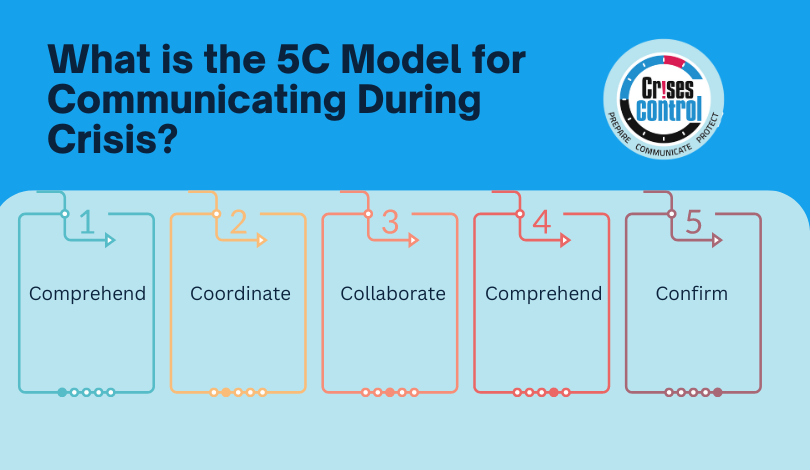In times of crisis, effective communication is crucial for organisations to navigate through challenges and maintain trust among stakeholders. The 5C model for critical communication provides a comprehensive framework that ensures clear, timely, and empathetic communication. In this blog, we will explore the key components of the 5C model and discuss how Crises Control, a leading crisis management company, can help organisations implement this model effectively.
Understanding the Importance of Critical Communication
During a crisis, organisations face various challenges that can affect their reputation, operations, and relationships with stakeholders. Effective critical communication plays a vital role in managing these challenges and minimising the negative impact. By proactively communicating with stakeholders, organisations can provide accurate information, address concerns, and maintain trust, which is essential for their survival and long-term success.
The 5C Model Explained
The 5C model offers a structured approach to critical communication, emphasising key aspects that organisations should consider when formulating their critical communication strategy.
Comprehend
In the first stage of the 5C model, it is essential to comprehend the nature and scope of the crisis. This involves gathering information, analysing the situation, and understanding the potential impact on stakeholders. By comprehending the crisis, organisations can develop an informed communication plan that addresses the specific needs and concerns of those affected.
Coordinate
Coordination is crucial during a crisis, as it ensures a unified and consistent approach to communication. It involves establishing a crisis management team, assigning roles and responsibilities, and implementing a centralised communication process. By coordinating efforts, organisations can avoid confusion and ensure that messages are consistent across all channels.
Collaborate
Collaboration is key to effective critical communication. It involves engaging with internal and external stakeholders, including employees, customers, partners, and the media. By involving all relevant parties, organisations can gather insights, address concerns, and leverage collective expertise to develop effective communication strategies.
Communicate
The communication stage focuses on delivering clear, accurate, and timely messages to the target audience. It is crucial to use appropriate channels and formats to reach stakeholders effectively. Transparent and empathetic communication helps build trust and enables stakeholders to make informed decisions during a crisis.
Confirm
The final stage of the 5C model is confirmation, which involves monitoring and evaluating the effectiveness of the communication efforts. By gathering feedback, organisations can identify areas for improvement and make necessary adjustments to their communication strategies. Continuous confirmation ensures that the messages are resonating with the audience and meeting their needs.
Applying the 5C Model in Practice
Now that we understand the components of the 5C model, let’s explore how organisations can apply this model in practice. Here are some practical steps to follow:
- Conduct a thorough analysis of the crisis to comprehend its impact and potential risks.
- Establish a crisis management team and define roles and responsibilities.
- Collaborate with stakeholders to gather insights and address concerns.
- Develop a crisis communication plan that includes key messages, target audiences, and communication channels.
- Communicate regularly and transparently, providing updates and accurate information.
- Monitor the effectiveness of communication efforts and make adjustments as needed.
How Crises Control Can Assist with Crisis Communication
Crises Control is a trusted provider of crisis management solutions, offering a comprehensive platform that helps organisations navigate through crises effectively. With our advanced and easy to use software, Crises Control can assist organisations in implementing the 5C model for crisis communication.
By leveraging Crises Control’s services, organisations gain access to:
- Real-time crisis alerting and notification systems
- Centralised communication channels for seamless coordination
- Data-driven insights and analytics to evaluate communication effectiveness
- Expert guidance and support throughout the crisis management process
Crises Control understands the importance of critical communication, crisis management, disaster recovery, and risk management. Our solutions are designed to empower organisations with the tools and resources needed to communicate efficiently during challenging times.
Conclusion
In conclusion, effective critical communication is paramount for organisations to navigate through crises successfully. The 5C model provides a structured framework that ensures clear, timely, and empathetic communication. By comprehending the crisis, coordinating efforts, collaborating with stakeholders, delivering effective communication, and confirming its impact, organisations can build trust and effectively manage crises.
To implement the 5C model and enhance your crisis communication capabilities, we recommend exploring the services offered by Crises Control. Request a live demo or get in touch with our experts to understand how their solutions can benefit your organisation.








